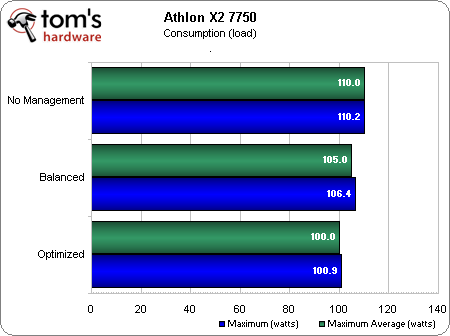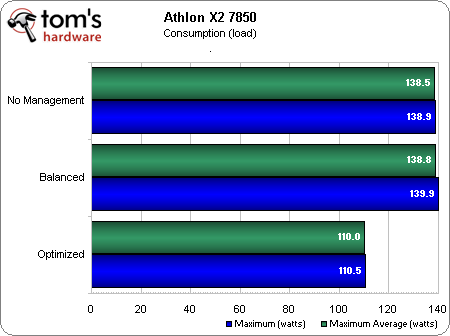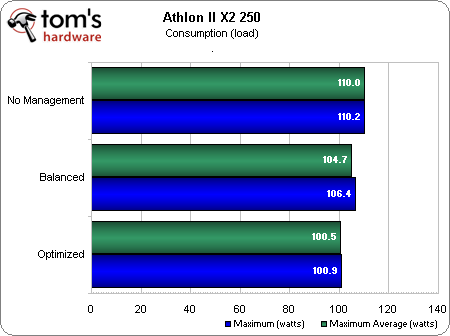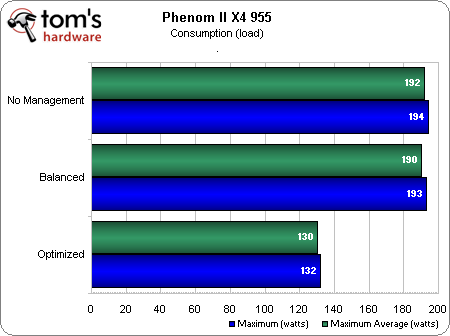Updated: Tuning Cool'n'Quiet: Maximize Power And Performance
Test Results: Load
What about the system power consumption under heavy and full load?
Athlon X2 7750
For the Athlon X2 7750, we saved about 5 watts with Cool'n'Quiet enabled, and gain as much by lowering the voltage. So, in effect, we've doubled the savings (about 10 to 18%), but the savings are actually quite small (10 watts versus 5 watts compared to no power management at all).
Athlon X2 7850
With the Athlon X2 7850, there’s really no difference between using no power management and enabling Cool'n'Quiet. We only save power when we lower the operating voltage, in which case power consumption went from 138 watts to 110 watts (a savings of 28 watts or 20%).
Athlon II X2 250
Compared to the other dual-core processors, the savings we see with Athlon II X2 250 seem small (from 110 watts to 106 watts with Cool'n'Quiet). But consider that this chip is already the most energy efficient of the three. With lowered voltages, system power consumption at full load is only 100 watts.
Get Tom's Hardware's best news and in-depth reviews, straight to your inbox.
Note: Pairing this processor to a Socket AM3-based motherboard brought down system power consumption at full load to just 84 watts. That means you should be able to save 10 to 15 watts just by moving to a modern platform.
Phenom II X3 710
With the Phenom II X3 710, there’s practically no difference in power consumption if we’re still using default voltages. Once you’ve lowered them (from 1.25V to 1.125V), we save quite a bit (around 16 to 19 watts or about 15%).
Phenom II X4 945
With all cores loaded, the system with the Phenom II X4 945 demands quite a bit of juice at default settings. Like the Phenom II X3 710, there’s practically no difference between not using power management and enabling Cool'n'Quiet with the “Balanced” policy. It’s only after we lower the voltages from 1.35/1.1V to 1.075/1.1V do we see any change--significant savings, we might add. We went from 176-177 watts to 124 watts (a savings of 53 watts or 29%).
Phenom II X4 955
The Phenom II X4 955 seems to consume about 15 watts more than the Phenom II X4 945, almost reaching 200 watts without voltage adjustments. With a little bit of voltage tweaking, you can lower power consumption to more manageable levels (130 watts).
Note: As with the Athlon II X2 250, we saw a similar drop in full load power consumption numbers for the Phenom II X4 955 on an AM3-based platform. Power consumption at load is about 120 watts. For those who are interested in running a quad core system under 100 watts, you definitely should look at the Athlon II X4 620. Power consumption at load is just 98 watts.
Current page: Test Results: Load
Prev Page Test Results: Idle, Continued Next Page Voltage Ramp And Power Consumption-
DrgnRebrn Nice article! I'm curious to know if the "e" CPUs can be affected in the same way, such as the Phenom II X3 705e. I have chosen this CPU for a HTPC build because of it's already low 65W TDP. Also, what are the effect to power usage when using ACC features & enabling dormant cores?Reply -
cyberkuberiah On the behalf of all readers , Welcome , and so to say , Hi! , Arnawa Widagda :)Reply -
Very good article! Undervolting it's a great tweak to make and most of the people don't even know that it is possible as well as overvolting, getting a power efficient processor for no money! Thanks tom's for caring about this matter.Reply
-
autoimmune Inf3rnalI'd like to see same article about Intel i5/i7 power setting tweaking. O my GOD i bet the writers at Toms Hardware had not thought of that, and are not currently in the process of writing that article!Reply
-
i love you guys. i have just the system that i am using as HTPC. i was wondering about ways to reduce the power usage as i dont use it for hardcore gaming or any other cpu intensive jobs. all i use it for watching blurays and tv and other movies and songs. i have an ASROCK 790gxh 128M mobo. and 1thlon x2 7750 kuma, that i bought from newegg for $59 (darn steal for the performance it gives. the machine has almost zero latency for any operation)Reply





